
Barbara Liskov is an American computer scientist who has made pioneering contributions to programming languages and distributed computing. Her notable work includes the introduction of abstract data types and the accompanying principle of data abstraction, along with the Liskov substitution principle, which applies these ideas to object-oriented programming, subtyping, and inheritance. Her work was recognized with the 2008 Turing Award, the highest distinction in computer science.

Beatrice Alice Hicks was an American engineer, the first woman engineer to be hired by Western Electric, and both co-founder and first president of the Society of Women Engineers. Despite entering the field at a time where engineering was seen as an inappropriate career for a woman, Hicks held a variety of leadership positions and eventually became the owner of an engineering firm. During her time there, Hicks developed a gas density switch that would be used in the U.S. space program, including the Apollo Moon landing missions.

Kansas City Kansas Community College (KCKCC) is a public two year community college in Wyandotte County, Kansas, United States. The college is accredited by the Higher Learning Commission, a commission of the North Central Association and the Kansas Board of Regents.
Central High School is a high school located at 3221 Indiana Avenue in Kansas City, Missouri. It is part of the Kansas City Public Schools. Central was established in 1867 in order to help educate the growing population of Kansas City. Formally located in downtown Kansas City, Missouri on 11th and Locust St, Central moved to its current location in 1912. The school colors are blue and white and the school's athletic teams are referred to as the "Eagles". Central has an enrollment of approximately 500 students annually.

Irene Kaminka Fischer was an Austrian-American mathematician and geodesist. She was a member of the National Academy of Engineering, a Fellow of the American Geophysical Union, and inductee of the National Imagery and Mapping Agency Hall of Fame. Fischer became one of two internationally known women scientists in the field of geodesy during the golden age of the Project Mercury and the Apollo program. Her Mercury datum, as well as her work on the lunar parallax, were instrumental in conducting these missions. "In his preface to the ACSM publication, Fischer's former colleague, Bernard Chovitz, referred to her as one of the most renowned geodesists of the third quarter of the twentieth century. Yet this fact alone makes her one of the most renowned geodesists of all times, because, according to Chovitz, the third quarter of the twentieth century witnessed "the transition of geodesy from a regional to a global enterprise."

Louis John Lanzerotti is an American physicist. He is a Distinguished Research Professor of physics in the Center for Solar-Terrestrial Research at New Jersey Institute of Technology (NJIT) in Newark, New Jersey.

John Call Cook was an American geophysicist who played a crucial role in establishing the field of ground-penetrating radar and is generally regarded as contributing the fundamental research to develop the field. Cook is also known for demonstrating that aerial surveys can map surface radioactivity to enable much more efficient prospecting for uranium ore, for inventing electrostatic detection of hazardous ice crevasses, and for developing other novel techniques in remote sensing.
Eleanor K. Baum is an American electrical engineer and educator. In 1984, she became the first female dean of an engineering school in the United States, at Pratt Institute in Brooklyn, New York.

Mary Plumb Blade was an American engineer, director of the Green Camp from 1955 to 1972, and full-time professor of mechanical engineering in the engineering school of The Cooper Union for the Advancement of Science and Art from 1946 to 1978.

Yvonne Y. Clark was a pioneer for African-American and women engineers. Also known as Y.Y., she was the first woman to earn a Bachelor of Science degree in mechanical engineering at Howard University, the first woman to earn a master's degree in Engineering Management from Vanderbilt University, and the first woman to serve as a faculty member in the College of Engineering and Technology at Tennessee State University, afterward becoming a professor emeritus.

Robin Elizabeth Bell is Palisades Geophysical Institute (PGI) Lamont Research Professor at Columbia University's Lamont–Doherty Earth Observatory and a past President of the American Geophysical Union (AGU), 2019–2021. Dr. Bell was influential in co-ordinating the 2007 International Polar Year and was the first woman to chair the National Academy of Sciences Polar Research Board. She has made numerous important discoveries with regard to subglacial lakes and ice sheet dynamics, and has a ridge, called Bell Buttress, in Antarctica named after her.

Diane McKnight is a distinguished professor of civil, environmental, and architectural engineering at the University of Colorado Boulder and a fellow at the Institute of Arctic and Alpine Research (INSTAAR). McKnight is a founding principal investigator of the National Science Foundation's Long-Term Ecological Research (LTER) program in the McMurdo Dry Valleys of Antarctica.

There may have been women in Antarctica, exploring the regions around Antarctica for many centuries. The most celebrated "first" for women was in 1935 when Caroline Mikkelsen became the first woman to set foot on one of Antarctica's islands. Early male explorers, such as Richard Byrd, named areas of Antarctica after wives and female heads of state. As Antarctica moved from a place of exploration and conquest to a scientific frontier, women worked to be included in the sciences. The first countries to have female scientists working in Antarctica were the Soviet Union, South Africa and Argentina.

Lois Graham was a professor of thermodynamics and cryogenics. She was the first woman to earn a mechanical engineering PhD in the United States.

Isabel Helen HardwichMInstP was an English electrical engineer, an expert in photometry, and fellow and president of the Women's Engineering Society.
Tuija I. Pulkkinen is a Finnish space physicist. Her primary research foci are studying the energy flow from the solar wind to the near-Earth space environment and the energy dissipation processes in the magnetosphere.
Sonia Maria Kreidenweis is an American Professor of Atmospheric Sciences at Colorado State University. Her research considers aerosols and their impact on weather and the climate. She has previously served as President of the American Association for Aerosol Research and was a board member of the American Meteorological Society. She was elected a Fellow of the American Geophysical Union in 2019.

Harriett B. Rigas FIEEE was a Canadian electrical engineer and innovative lecturer who was recognised worldwide for her hybrid computer and computer simulation research.
Dawn Marie Tilbury is an American control theorist whose research topics include logic control, networked control systems, robotics, human–machine systems, and autonomous vehicles. She is a professor of mechanical engineering and of electrical engineering and computer science at the University of Michigan, and the head of the directorate for engineering at the National Science Foundation.
Margaret Ann ("Peggy") Shea is a space scientist known for research on the connections between cosmic radiation and Earth's magnetic field.














